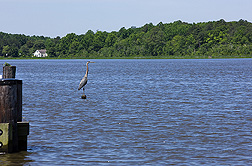This page has been archived and is being provided for reference purposes only. The page is no longer being updated, and therefore, links on the page may be invalid.
| Read the magazine story to find out more. |
|
|
| See our information kit to find out more. |
|
|
CEAP Study Examines Nitrogen, Copper Levels in Bay Watershed
By Don ComisAugust 20, 2010
A comprehensive study of pollutants in a major Chesapeake Bay tributary revealed troublesome levels of nitrogen and copper that could flow into the Bay, according to U.S. Department of Agriculture (USDA) scientists and their cooperators.
Scientists with USDA's Agricultural Research Service (ARS) and their collaborators conducted the study as part of the Conservation Effects Assessment Project (CEAP) for Maryland's Choptank River Watershed, which flows into the Chesapeake Bay. CEAP began in 2004 and focuses on the effects of conservation practices and Farm Bill conservation programs on 37 watersheds nationwide.
Greg McCarty, a soil scientist with the ARS Hydrology and Remote Sensing Laboratory at Beltsville, Md., and Laura McConnell, a chemist at the ARS Environmental Management and Byproducts Utilization Laboratory in Beltsville, lead the team's CEAP Choptank project. ARS is USDA's principal intramural scientific research agency.
Monitoring the Choptank provides information needed to develop new conservation practices, refine existing ones, and design programs to evaluate efforts to clean the endangered Bay.
Sampling the water every two months for three years, the scientists found that nitrate concentrations often exceeded levels that can cause algal blooms. Nitrate concentrations were highest at the headwaters where farming is concentrated, suggesting that agricultural fertilizers, including manure and poultry litter, are primary sources.
But phosphorus concentrations were similar throughout the river, suggesting multiple sources. While some evidence points to wastewater treatment plants as a likely primary source, agriculture is also a major contributor.
High copper concentrations were found in almost all samples at the lower reaches of the Choptank, but not in the upstream areas. This suggests that agriculture is not the primary source. The levels were high enough to be toxic to clams and other aquatic invertebrates that help feed and filter the Bay.
Herbicides and their byproducts were present year-round. Concentrations did not approach established levels of concern for aquatic organisms. Still, this research shows the importance of agricultural practices that reduce herbicide losses, particularly from springtime applications.
The results of this study were published in the journal Science of the Total Environment.
Read more about this research in the August 2010 issue of Agricultural Research magazine.

